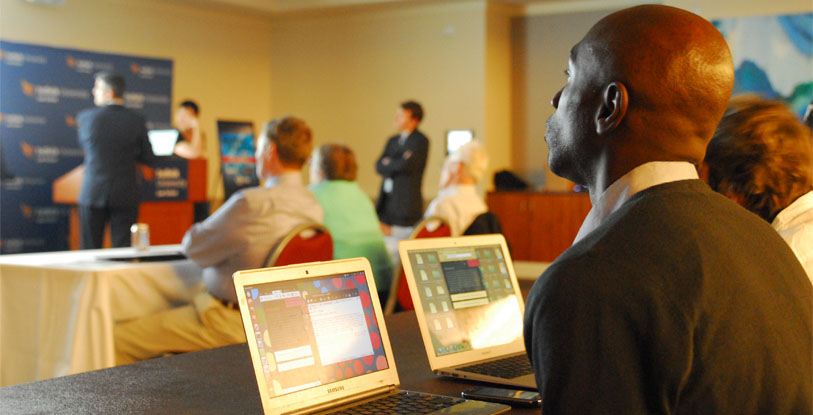Lawyers and legal scholars know all too well that low-income citizens lack speedy, efficient access to the justice system. Now, in an age when people from all economic levels own some kind of hand-held mobile device, legal service advocates believe smart, efficient Web-based technology can bridge that divide.
And so was born the first “Hackcess to Justice” competition, held by Suffolk Law School on August 7 and 8, in partnership with the American Bar Association Journal.
The effort was modeled after the popular hackathon concept, in which programmers and specialists in fields like medicine, education, and now law join forces for 48 hours to create free applications and other Internet tools aimed at making life easier for citizens and professionals from all walks of life.
“The noblest of ventures”
James J. Sandman, president of the Legal Services Corporation, kicked off the encoding effort by telling dozens of participants they were “about to embark on the noblest of ventures.” In courts across the nation, he said, millions of Americans seeking justice lack representation, while funding for legal aid is waning. Technology, he said, is the greatest hope for those who seek basic courtroom access but do not have a lawyer by their side.
“Our goal is to help simplify the legal system,” he said.
Focused on helping others
Participants, among them lawyers, software developers, and public service advocates, then charged ahead, creating an ingenious array of interactive tools while vying for prizes of $1,500, $1,000 and $500 for finishing first, second, or third in the eyes of a three-judge panel.
“To watch these lawyers who, on their personal time, are so dedicated to solving the problem of solving problems for others is just plain awesome,” said Allen Pusey, editor and publisher of the ABA Journal.
Five finalists emerged at the end of the 48-hour techno-sprint, which left participants – many of them learning programming and coding on the fly – elated and exhausted. The top ideas, based on execution, innovation, impact, and overall creativity and appeal, were:
- disastr: A disaster-relief mobile app, inspired by lawyers who helped victims of Hurricane Sandy in 2012, that connects victims to a wide range of agencies that provide relief money, housing, insurance advice, and legal aid.
- Due Processor: An interactive tool that lets people calculate whether they qualify for government-funded legal aid, based on their income, and also lets defendants determine how much prison time they might face based on the crime and relevant sentencing guidelines.
- Legal Apptitude: An online role-playing game designed to help indigent defendants determine whether they have the skills to represent themselves in court.
- Divorce Decoded: A user-friendly Web site that guides individuals and legal advocates through the basic process, timeline and forms needed for obtaining a simple divorce.
- PaperHealth: An app that allows users to create legally binding health care proxies and non-binding living wills that can be saved online and sent as needed to medical providers, health care companies, and hospitals and made accessible to third parties via personal devices in cases of emergencies.
The teams behind the “top hacks” presented their ideas before the three judges and an audience of enthusiastic spectators, many from the Law School’s nationally recognized Institute on Law Practice, Technology & Innovation.
Sandman hailed the innovators, saying: “You all demonstrated the ability to put yourself in the shoes of another person and figure out what they need and how you might help.”
Winning entries
First place went to lawyer William E. Palin, a 2012 Suffolk Law graduate and health care advocate who created PaperHealth. Palin noted that many people have no plans in place for medical emergencies and said that helping them create simple signed personal documents can help bring down health care costs.
“We have to pull our industry further in the direction of online documents so we don’t have to fill out a hundred million forms,” Palin said. He said he plans to make the service available for free on Apple’s App Store.
Second prize went to “disastr,” conceived by Matthew Burnett, director of the Immigration Advocacy Network, and Adam Friedl of Pro Bono Net.
Third prize was awarded to Due Processor, built by David Zvenyach, a Washington lawyer, David Colarusso, an attorney with the Massachusetts Committee for Public Counsel Services, and William Li, a computer science PhD candidate at the Massachusetts Institute of Technology.
“Although technology in and of itself can’t fully solve the access to justice gap, it is a significant tool that can make a real difference to many people, as evidenced by the projects that were shown at the hackathon,” said Rochelle Hahn of the Massachusetts Law Reform Institute, who was on the lookout for new ideas for MassLegalServices, an online poverty law resource center.
Pusey said he was thrilled by the “astounding dedication” shown by the participants and looked forward to more legal hackathons.
“Really, it was one of the most inspiring events I’ve been associated with,” he said.


